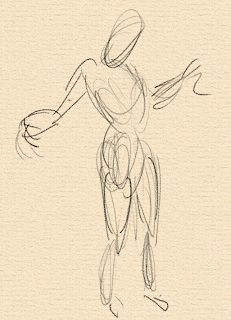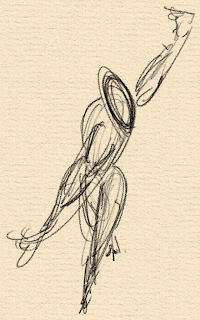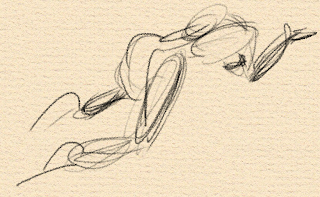Blind contour drawing is the second focus in Schedule One of Kimon Nicolaides ‘The Natural Way to Draw’. The time spent on this exercise will amount to almost nine hours for this schedule. The use of a live model is highly recommended in the book, but you can make some clever substitutions for each exercise. Once again it is important that you draw for the total time as instructed for each session.
Blind contour is the practice of drawing a model or object without looking at the paper. The exercise will develop your observational skills and improve your hand-eye coordination. Blind contour drawing trains your eye to draw what it really sees (right brain process) rather than what it thinks it sees (left brain process). It will force the artistic side of your brain, the right side, to take control of the pencil as you draw on the paper.
Kimon Nicolaides recommends that you follow a few guidelines to get the most benefits from the exercise. The first guideline is keep your eyes on the outline of the model or object at all times. You may glance at the paper to place an internal feature, but once you begin to draw it, do not look down, but follow the same procedure as for the outline. The second guideline is draw the contour very slowly in a steady, continuous line without lifting the pencil or looking at the paper. The last guideline is that you should imagine the pencil is really touching the model. Feel your pencil move along the contour of the model at all times. Stop drawing if you lose that feeling and don’t continue until the feeling returns to you.
The exercise should be completed using a model or object from real life. The human body is a perfect model for blind contour drawing. Plants, trees, and sleeping animals would also be a good choice for this exercise. I have successfully used various toys and figurines in a still life for blind contour drawing. Look around your environment and you will be surprised to find that a model is always available for you.
I am nearing the end of Schedule One and I have noticed some things about myself. I am finally learning to have patience during the blind contour exercises. I felt, in the beginning, that this exercise was dreadfully boring for me. I was trying to draw to fast and I was not benefiting from the exercise. I decided to switch to my non dominant hand for drawing every other session. Switching hands has really helped me slow down and feel my way around the contour of the model. I highly recommend you try drawing with your non dominant hand next time.
I have also learned that it is possible to really feel like the pencil is touching the surface of the model. I can tell when I have lost that feeling, too. I notice my drawing contains many more curves and bumps when I feel like the pencil is touching the model. It is almost like I have a heightened awareness of the model’s surface. I feel like I am starting to accurately see the model during each session. I have posted a couple of drawings below for you to see as an example. Do you notice the difference between the first session image and the latest session image?
Thank you for stopping by the blog and reading up on my progress. I hope you are learning something useful from my experience. I will be posting about Cross Contour drawing in the next article. See you next time!
Sunday, April 10, 2011
Sunday, April 3, 2011
Are You Ready for Gesture Drawing?
Gesture drawing is one of the main focuses of Schedule One in Kimon Nicolaides ‘The Natural Way to Draw’. Schedule One requires fifteen hours of drawing and some light reading between sessions. A model is preferred for the exercises, but you can make a substitution if a model is unavailable. The real key is that you are drawing for the time allowed in each session.
Gesture drawing is, generally, a series of poses taken by a model and drawn in one minute or less by the artist. It is an attempt to capture action, movement, or feeling in your drawing. Gesture drawing will help you study the human figure in motion. You will gain a better understanding of muscle exertion, range of motion in the joints, and the effects of twisting in the human body.
Kimon Nicolaides stresses the importance of feeling the pose in your own body before you attempt to draw the pose. You may find, like me, that it will take some practice before you will be able to feel the pose. I have been known to actually get out of my seat and briefly hold the pose myself. I have found that it truly helps me capture the feeling on paper. You should give it a try during your next gesture session.
You may find difficulty in locating a willing model for your gesture studies. I have had great results using a couple of substitutes for a live model during my sessions. The first substitute is any sporting event on television (or real life). Football, boxing, gymnastics and baseball contain some fantastic live action poses. You could even try watching an action packed movie and capturing the various movements in your drawings.
The second substitute I use, most frequently, is an extremely useful website called Posemaniacs. I highly recommend this website if you can not obtain a live model for your gesture drawings. The website hosts a slide show that randomly displays 2 dimensional poses of the human figure. You can set a timer for the poses and even view them full screen on your computer monitor. The Posemaniacs slide show application is free to all users and can be accessed at http://www.posemaniacs.com/thirtysecond.
I have been working through Schedule One at a snail’s pace due to time constraints in my personal life. I have just completed session 1C and I already notice a slight improvement in my drawing. I still struggle with capturing the essence of the gesture quickly. Sometimes I find that I have spent too much time feeling the pose before putting my pencil to the paper. During a good session I feel that I have only a few great gesture drawings in the end. I thought I would include a few at the end of this post for you to view as an example. See you next time!



Gesture drawing is, generally, a series of poses taken by a model and drawn in one minute or less by the artist. It is an attempt to capture action, movement, or feeling in your drawing. Gesture drawing will help you study the human figure in motion. You will gain a better understanding of muscle exertion, range of motion in the joints, and the effects of twisting in the human body.
Kimon Nicolaides stresses the importance of feeling the pose in your own body before you attempt to draw the pose. You may find, like me, that it will take some practice before you will be able to feel the pose. I have been known to actually get out of my seat and briefly hold the pose myself. I have found that it truly helps me capture the feeling on paper. You should give it a try during your next gesture session.
You may find difficulty in locating a willing model for your gesture studies. I have had great results using a couple of substitutes for a live model during my sessions. The first substitute is any sporting event on television (or real life). Football, boxing, gymnastics and baseball contain some fantastic live action poses. You could even try watching an action packed movie and capturing the various movements in your drawings.
The second substitute I use, most frequently, is an extremely useful website called Posemaniacs. I highly recommend this website if you can not obtain a live model for your gesture drawings. The website hosts a slide show that randomly displays 2 dimensional poses of the human figure. You can set a timer for the poses and even view them full screen on your computer monitor. The Posemaniacs slide show application is free to all users and can be accessed at http://www.posemaniacs.com/thirtysecond.
I have been working through Schedule One at a snail’s pace due to time constraints in my personal life. I have just completed session 1C and I already notice a slight improvement in my drawing. I still struggle with capturing the essence of the gesture quickly. Sometimes I find that I have spent too much time feeling the pose before putting my pencil to the paper. During a good session I feel that I have only a few great gesture drawings in the end. I thought I would include a few at the end of this post for you to view as an example. See you next time!



Subscribe to:
Posts (Atom)

